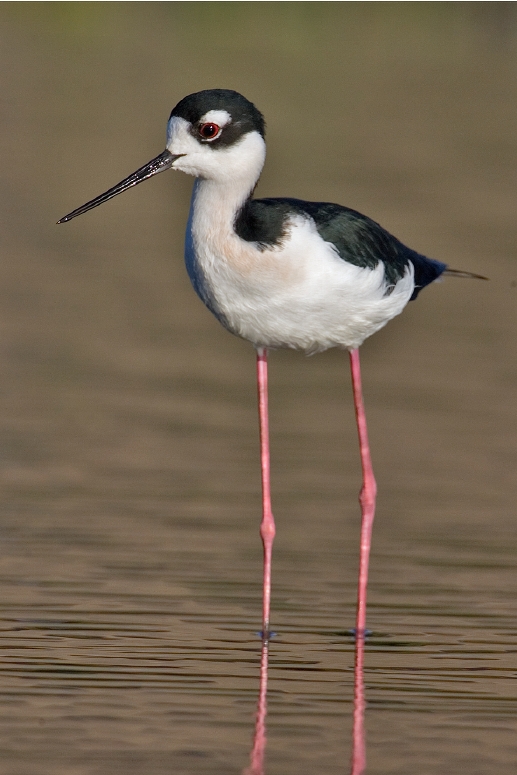Black-necked Stilt (Himantopus mexicanus) - Wiki Black-necked Stilt
From Wikipedia, the free encyclopedia
[Photo] Black-necked Stilt (Himantopus mexicanus), San Joaquin Wildlife Sanctuary, Near Huntington Beach, California. Date December 2006. Author Alan D. Wilson (http://www.naturespicsonline.com/)
The Black-necked Stilt (Himantopus mexicanus) is a locally abundant resident of American wetlands and coastlines, from the coastal areas of California, much of the interior western United States and along the Gulf of Mexico as far east as Florida, then south to Peru, northern Brazil and the Galapagos islands. Northern populations are migratory, wintering from the extreme south of the USA to southern Mexico, rarely as far south as Costa Rica
In the south of its range Black-necked Stilt intergrades with the South America form Himantopus (himantopus) melanurus.
Adults have long pink legs, a long thin black bill and are mainly white below with a black cap, neck and back.
Habitat
The Black-necked Stilt is found in estuarine, lacustrine, salt pond and emergent wetland habitats over the range noted above. It is also found in seasonally ponded wetlands. In the US, use of salt evaporation ponds has increased significantly since 1960 and may now be the primary wintering habitat. In the Salton Sea locale, the Black-necked Stilt is resident year-round. The species also breeds along lake shores in northeastern California and southeastern Oregon as well as along the Colorado River.
This species rarely breed inland outside California, but is known as a breeding bird in riparian locales in Arizona. In Arizona, Black-necked Stilts may been seen along artificially-created lakes and drainage basins in the Phoenix metropolitan area, in remnant riparian habitat.
Range
This bird is locally abundant in the San Joaquin Valley, where he commonly winters. This species is common to locally abundant in these same habitats in Southern California from April to September. In the Salton Sea locale, the Black-necked Stilt is resident year-round. The species also breeds along lake shores in northeastern California and southeastern Oregon as well as along the Colorado River. Use of salt evaporation ponds has increased significantly since 1960 and may now be the primary wintering habitat; these salt ponds are especially prevalent in southern San Francisco Bay.
Specific locations where one would expect to view the Black-necked Stilt in the San Francisco Bay Area are Richardson Bay (especially, according to mudflat bird sightings, the mouth of Picklewood Creek), mudflats of Belmont Slough, mudflats of Seal Slough in San Mateo , salt ponds in Hayward, California and exposed bay muds on the Burlingame, California estuarine shore.
For the populations that summer in the Sierra Nevada of northeast California and southeastern Oregon as well as the plateau lakes of those areas, breeding occurs after those flocks migrate to lowland and coastal areas each August or September. For flocks that summer in the northern Central Valley of California, a migration occurs to the San Joaquin Valley to consolidate with flocks that were already summering there. In coastal areas flocks both summer and winter in these estuarine settings.
Behaviour
This species forages by probing and gleaning primarily in mudflats and lakeshores, but also in very shallow waters near shores; it seeks out crustaceans, arthropods mollusks, aquatic invertebrates and small fish. For feeding areas the Black-necked Stilt prefers coastal estuaries, salt ponds, lakeshores, alkali flats and even flooded fields. For roosting and resting needs, this bird selects alkali flats (even flooded ones), lake shores, and islands surrounded by shallow water.
Breeding
This species of stilt chooses mudflats, desiccated lacustrine verges, and levees for nest locations, as long as the soil is friable. Reproduction occurs from late April through August, with peak activity in June. The nests are typically sited within one kilometer of a feeding location, and the Black-necked Stilt defends an extensive perimeter around groups of nests, patrolling in cooperation with its neighbors Spacing between nests is approximately 20 meters, but sometimes nests are within two meters of each other and some nests in the rookery are as far as 40 meters from the nearest neighbor. The species is actually classified as semicolonial since the nests are scattered in loose clusters. The nests are frequently established rather close to the water edge, so that their integrity is affected by rising water levels of ponds or tides. This is particularly a hazard in the case of managed salt ponds where water levels may be altered rapidly in the salt pond flooding process.
The clutch size generally is three to five eggs with an average of four. For three and one half weeks both sexes take turns incubating the eggs. The young are so precocial that they are seen swimming within two hours after hatching and are also capable of rapid land velocity at that early time. In spite of this early development the young normally continue to reside in the nest for two days.
Taxonomy
Some sources believe that there are as many as five distinct species of stilt, though others consider them to be all subspecies of the Black-winged Stilt. The North American variant, the Black-necked Stilt, has a dark head as well with a white spot over the eye. It is recorded as Himantopus mexicanus in the Sibley-Monroe checklist. The North American Black-necked Stilt is migratory and moves to the Pacific coast or San Joaquin Valley to winter.
http://en.wikipedia.org/wiki/Black-necked_Stilt
| The text in this page is based on the copyrighted Wikipedia article shown in above URL. It is used under the GNU Free Documentation License. You may redistribute it, verbatim or modified, providing that you comply with the terms of the GFDL. |
